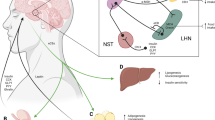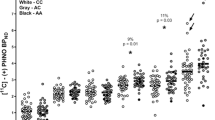Abstract
BACKGROUND:
The brain endogenous cannabinoid system modulates reward and craving pathways and consequently may affect body weight. A naturally occurring missense polymorphism in the gene encoding fatty acid amide hydrolase (FAAH), the primary enzyme for inactivation of endocannabinoids, is associated with problem drug use.
AIMS:
To investigate the relationship between the FAAH cDNA 385 A/A (P129T) polymorphism and overweight disorders in subjects of multiple ethnic backgrounds attending a medical screening clinic.
SUBJECTS:
A total of 2667 subjects of white, black and Asian ancestry were genotyped and stratified by a standardized clinic-based assessment of body mass index (BMI, weight in kilograms/(height in meters)2 or kg/m2).
METHODS:
Subjects were genotyped for the FAAH cDNA 385 C → A polymorphism using allele-specific oligonucleotide hybridization methods by investigators blinded to all clinical information. BMI was calculated based on exact clinical measurements and World Health Organization ranges were used to stratify subjects. Statistical methods included the Fisher exact test, Mann–Whitney U-test and multivariable logistic regression analysis.
RESULTS:
The homozygous FAAH 385 A/A genotype was significantly associated with overweight and obesity in white subjects (P=0.005) and in black subjects (P=0.05) but not in a small group of Asians. The median BMI for all subjects was significantly greater in the FAAH 385 A/A genotype group compared to heterozygote and wild-type groups (P=0.0001). In white subjects, there was an increasing frequency of the FAAH 385 A/A genotype with increasing BMI categories of overweight (P=0.02) and obese (P=0.006) with the same trend in black subjects.
CONCLUSIONS:
These results suggest a role for the FAAH 385 A/A missense polymorphism as an endocannabinoid risk factor in overweight/obesity and may provide indirect evidence to support cannabinoid antagonist treatment strategies in overweight disorders.
This is a preview of subscription content, access via your institution
Access options
Subscribe to this journal
Receive 12 print issues and online access
$259.00 per year
only $21.58 per issue
Buy this article
- Purchase on Springer Link
- Instant access to full article PDF
Prices may be subject to local taxes which are calculated during checkout

Similar content being viewed by others
References
Mokdad A, Ford E, Bowman B, Dietz W, Vinicor F, Bales V, Marks J . Prevalance of obesity, diabetes, and obesity-related health risk factors, 2001. JAMA 2003; 289: 76–79.
Tiwari H, Allison D . Do allelic variants of SLC6A14 predispose to obesity? J Clin Invest 2003; 112: 1633–1636.
Ameri A . The effects of cannabinoids on the brain. Prog Neurobiol 1999; 58: 315–348.
Matsuda LA, Lolait SJ, Brownstein MJ, Young AC, Bonner TI . Structure of a cannabinoid receptor and functional expression of the cloned cDNA. Nature 1990; 346: 508.
Brown SM, Wager-Miller J, Mackie K . Cloning and molecular characterization of the rat CB2 cannabinoid receptor. Biochim Biophys Acta 2002; 1576: 255–264.
Egertova M, Giang DK, Cravatt BF, Elphick MR . A new perspective on cannabinoid signalling: complementary localization of fatty acid amide hydrolase and the CB1 receptor in rat brain. Proc R Soc Lond Ser B 1998; 265: 2081–2085.
Egertova M, Elphick MR . Localisation of cannabinoid receptors in the rat brain using antibodies to the intracellular C-terminal tail of CB. J Comp Neurol 2000; 422: 159–171.
Fride E . Endocannabinoids in the central nervous system-an overview 1. Prostaglandins Leukot Essent Fatty Acids 2002; 66: 221–233.
Cravatt BF, Giang DK, Mayfield SP, Boger DL, Lerner RA, Gilula NB . Molecular characterization of an enzyme that degrades neuromodulatory fatty-acid amides. Nature 1996; 384: 83–87.
Deutsch DG, Ueda N, Yamamoto S . The fatty acid amide hydrolase (FAAH) 1. Prostaglandins Leukot Essent Fatty Acids 2002; 66: 201–210.
Cravatt BF, Demarest K, Patricelli MP, Bracey MH, Giang DK, Martin BR, Lichtman AH . Supersensitivity to anandamide and enhanced endogenous cannabinoid signaling in mice lacking fatty acid amide hydrolase. Proc Natl Acad Sci USA 2001; 98: 9371–9376.
Lichtman AH, Hawkins EG, Griffin G, Cravatt BF . Pharmacological activity of fatty acid amides is regulated, but not mediated, by fatty acid amide hydrolase in vivo. Pharmacol Exp Ther 2002; 302: 73–79.
Sipe JC, Chiang K, Gerber AL, Beutler E, Cravatt BF . A missense mutation in human fatty acid amide hydrolase associated with problem drug use. Proc Natl Acad Sci USA 2002; 99: 8394–8399.
Flier JS . Obesity wars: molecular progress confronts an expanding epidemic. Cell 2004; 116: 337–350.
Cota D, Marsicano G, Tschop M, Grubler Y, Flachskamm C, Schubert M, Auer D, Yassouridis A, Thone-Reineke C, Ortmann S, Tomassoni F, Cervino C, Nisoli E, Linthorst AC, Pasquali R, Lutz B, Stalla GK, Pagotto U . The endogenous cannabinoid system affects energy balance via central orexigenic drive and peripheral lipogenesis. J Clin Invest 2003; 112: 423–431.
Harrold JA, Williams G . The cannabinoid system: a role in both the homeostatic and hedonic control of eating? Br J Nutr 2003; 90: 729–734.
Chiang K, Gerber AL, Sipe JC, Cravatt BF . Reduced cellular expression and activity of the P129T mutant of human fatty acid amide hydrolase: evidence for a link between defects in the endocannabinoid system and problem drug use. Hum Mol Genet 2004; 13: 1–7.
Beutler E, Gelbart T . Large-scale screening for HFE mutations: methodology and cost. Genet Test 2000; 4: 131–142.
Choo V . WHO reassesses appropriate body-mass index for Asian populations. Lancet 2002; 360: 235.
Wang J, Thornton J, Burastero S, Shen J, Tanenbaum S, Heymsfield S, Pierson Jr R . Comparison for body mass index and body fat percent among Puerto Ricans, blacks, whites and Asians living in the New York City area. Obesity Res 1996; 4: 377–384.
Wilson RI, Nicoll RA . Endocannabinoid signaling in the brain. Science 2002; 296: 678–682.
Iversen L . Cannabis and the brain. Brain 2003; 126: 1252–1270.
Elphick MR, Egertova M . The neurobiology and evolution of cannabinoid signalling. Philos Trans R Soc Lond Ser B 2001; 356: 381–408.
Di Marzo V, Melck D, Bisogno T, De Petrocellis L . Endocannabinoids: endogenous cannabinoid receptor ligands with neuromodulatory action. Trends Neurosci 1998; 21: 521–528.
Ohno-Shosaku T, Maejima T, Kano M . Endogenous cannabinoids mediate retrograde signals from depolarized postsynaptic neurons to presynaptic terminals. Neuron 2001; 29: 729–738.
Christie MJ, Vaughan W . Cannabinoids act backwards. Nature 2001; 410: 527–530.
Di Marzo V, Bisogno T, De Petrocellis L, Melck D, Martin BR . Cannabimimetic fatty acid derivatives: the anandamide family and other endocannabinoids. Curr Med Chem 1999; 6: 721–744.
Robbe D, Alonso G, Duchamp F, Bockaert J, Manzoni OJ . Localization and mechanisms of action of cannabinoid receptors at the glutamatergic synapses of the mouse nucleus accumbens. J Neurosci 2001; 21: 109–116.
Szabo B, Siemes S, Wallmichrath I . Inhibition of GABAergic neurotransmission in the ventral tegmental area by cannabinoids. Eur J Neurosci 2002; 15: 2057–2061.
Robbe D, Kopf M, Remaury A, Bockaert J, Manzoni OJ . Endogenous cannabinoids mediate long-term synaptic depression in the nucleus accumbens. Proc Natl Acad Sci USA 2002; 99: 8384–8388.
Cota D, Marsicano G, Lutz B, Vicennati V, Stalla GK, Pasquali R, Pagotto U . Endogenous cannabinoid system as a modulator of food intake. Int J Obes Relat Metab Disord 2003; 27: 289–301.
Di Marzo V, Goparaju SK, Wang L, Liu J, Batkai S, Jarai Z, Fezza F, Miura GI, Palmiter RD, Sugiura T, Kunos G . Leptin-regulated endocannabinoids are involved in maintaining food intake. Nature 2001; 410: 822–825.
Harrold JA, Elliott JC, King PJ, Widdowson PS, Williams G . Down-regulation of cannabinoid-1 (CB-1) receptors in specific extrahypothalamic regions of rats with dietary obesity: a role for endogenous cannabinoids in driving appetite for palatable food? Brain Res 2002; 952: 232–238.
Ravinet Trillou C, Arnone M, Delgorge C, Gonalons N, Keane P, Maffrand JP, Soubrie P . Anti-obesity effect of SR141716, a CB1 receptor antagonist, in diet-induced obese mice. Am J Physiol Regul Integr Comp Physiol 2003; 284: R345–R353.
Egertova M, Cravatt BF, Elphick MR . Comparative analysis of fatty acid amide hydrolase and cb(1) cannabinoid receptor expression in the mouse brain: evidence of a widespread role for fatty acid amide hydrolase in regulation of endocannabinoid signaling. Neuroscience 2003; 119: 481–496.
Acknowledgements
This work was supported by National Institutes of Health Grants DA 015749, DK53505-02, and MO1 RR00833, by the Skaggs Scholars in Clinical Science Program from The Scripps Research Institute and by the Sam and Rose Stein Endowment Fund. This is manuscript number 16668-MEM from The Scripps Research Institute.
Author information
Authors and Affiliations
Corresponding author
Rights and permissions
About this article
Cite this article
Sipe, J., Waalen, J., Gerber, A. et al. Overweight and obesity associated with a missense polymorphism in fatty acid amide hydrolase (FAAH). Int J Obes 29, 755–759 (2005). https://doi.org/10.1038/sj.ijo.0802954
Received:
Revised:
Accepted:
Published:
Issue Date:
DOI: https://doi.org/10.1038/sj.ijo.0802954
Keywords
This article is cited by
-
Research progress in the management of vascular disease with cannabidiol: a review
Journal of Cardiothoracic Surgery (2024)
-
Association between the FAAH C385A variant (rs324420) and obesity-related traits: a systematic review
International Journal of Obesity (2024)
-
The CB1 cannabinoid receptor regulates autophagy in the tibialis anterior skeletal muscle in mice
Biological Research (2023)
-
Circulating endocannabinoid levels in pregnant women with gestational diabetes mellitus: a case–control study
BMC Endocrine Disorders (2022)
-
The Endocannabinoid System and Eating Behaviours: a Review of the Current State of the Evidence
Current Nutrition Reports (2022)



